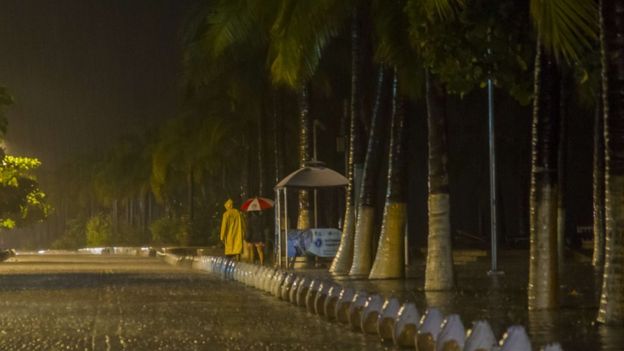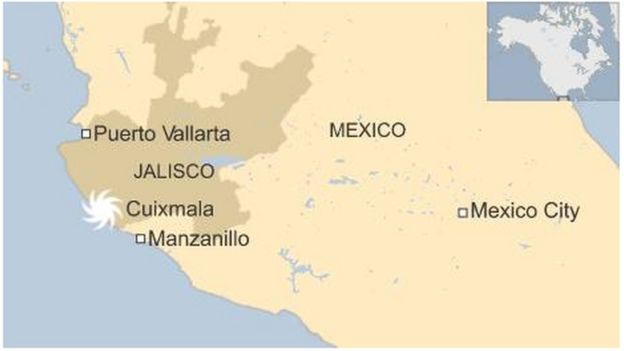
Hurricane Patricia, photographed here from the International Space Station, hit Mexico with 265km/h (165mph) winds
Mexico’s president has warned that Hurricane Patricia still poses a threat of floods and landslides as it brings heavy rain to parts of the country.
President Enrique Pena Nieto said Patricia – the strongest storm recorded in the Americas – had so far caused less damage than feared.
The US National Hurricane Centre said the hurricane hit as a Category Five storm – the highest classification.
It has since been downgraded to a Category Two tropical storm.

Hurricane Patricia brought heavy rain to Mexico’s Pacific coast as it approached on Friday
The storm touched down in western Mexico, bringing destructive winds and rain, but heavy damage appears to have been avoided.
The NHC said winds had decreased to 155 km/h (100 mph) as the storm weakened over land.
While still over the ocean, Patricia had winds of 325 km/h (200 mph) at its peak, which made it the most powerful hurricane ever recorded in the Western hemisphere.
Patricia is now moving north-northeastward inland over northern Mexico.
The states of Nayarit, Jalisco, Colima, Michoacan, and Guerrero are in particular danger as the storm moves inland, the centre says.
“The first reports confirm that the damage has been smaller than that corresponding to a hurricane of this magnitude,” Mr Pena Nieto said in a televised address.
Mexican federal police said only “minor landslides and fallen trees” had so far been reported in Colima.
But the government has warned that ash from the Colima volcano, which has become increasingly active this year, could combine with heavy rainfall to trigger huge mudflows.
Some 400,000 people live in vulnerable areas, according to Mexico’s National Disaster Fund.
Hurricane Patricia: As it happened
Key questions about Hurricane Patricia

Patricia reached land in the Cuixmala area of the western Jalisco state, some 85km (55 miles) from the port city of Manzanillo.
The US National Hurricane Centre said Patricia hit the coast with winds of 265km/h (165mph).
At one point before landfall, the hurricane’s winds had been strong enough “to get a plane in the air and keep it flying”, World Meteorological Organization spokeswoman Claire Nullis said.
Video filmed in the port city of Manzanillo shortly before the hurricane struck showed trees bending in severe wind.
While sheltering with his family in Manzanillo, Jacob Lozano Salazar told the BBC: “We’re all safe but it’s really ugly here on the coast.”
Residents had stocked up on food and other supplies, while shop owners boarded up windows.
Jalisco is home to the resort town of Puerto Vallarta, which appeared to have escaped the worst of the storm.
Police patrols in the resort urged people to leave the shorefront for safer areas at least three blocks inland, while loudspeakers ordered hotel residents to evacuate.
The town’s airport, along with two others in the path of the storm, were closed.
Some of the most powerful storms in recent years
- October 1979: Typhoon Tip – largest and most intense tropical cyclone ever recorded with wind speeds of 305km/h (190mph), killed 99 people in its path across the Pacific, mostly in Japan
- August 1980: Hurricane Allen – strongest Atlantic hurricane by wind speed, with sustained winds of 305km/h, caused nearly 300 deaths in Haiti and severe damage in the US state of Texas
- April 1991: Bangladesh cyclone known as 02B – at least 138,000 died and up to 10 million made homeless after a 6m storm surge
- October 1991: Odisha or Paradip cyclone – the strongest ever recorded in the northern Indian Ocean, killed about 10,000 people, mostly in India
- August 2005: Hurricane Katrina – killed at least 1,836 people after striking US states of Louisiana and Mississippi and was the costliest storm in history, causing $81.2bn in damage (with wind speeds of 280km/h)
- October 2005: Hurricane Wilma – most intense tropical cyclone in the Atlantic basin with wind speeds of 295km/h, killing 87 people on its path through the Caribbean and Gulf of Mexico
- November 2013: Typhoon Haiyan – the strongest storm recorded at landfall, with one-minute sustained wind speeds of 315km/h, it devastated parts of the Philippines, killing at least 6,300 people
BBC
 Q FM Africa's Modern Radio
Q FM Africa's Modern Radio